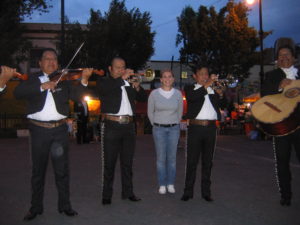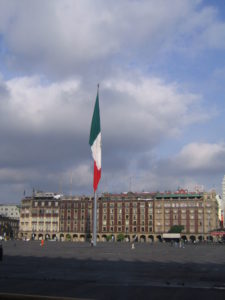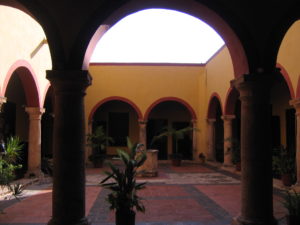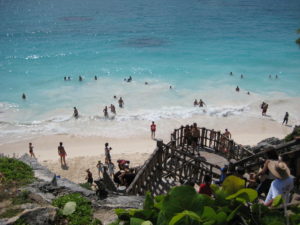
Mariachi Band in MC
During my studies I had to do six months internship and I had the opportunity to do that in Los Cabos in Mexico. As I knew after my internship I wouldn’t have much time before heading for my semester abroad in Australia, the only possibility was to travel around Mexico before I started my work placement. I usually don’t like traveling in an organized tour group (which I have never done before), but having only 16 days available and I wanted to see as much as possible and this was the only option for me.
So in a 14 day tour from Mexico City to Cancun, I was able to see the highlights of Mexican culture with its cities, cathedrals, Maya ruins, and all sorts of different ranging from landscapes of mountains, jungles, beaches and more.

Zócalo
The trip started in Mexico City where we had to compress the two full days scheduled into one day, due to a flight delay from Germany. Mexico City with a population of almost 9 million is the capital and the most populated city in Mexico. The city tour included visits of “Paseo de la Reforma”, a wide avenue built after the boulevards in Europe such as Champs-Élysées in Paris with one of the most famous monuments “The Angel of Independence”, the Zócalo, which is the main square also called “Plaza de la Constitución” surrounded by the main cathedral and the national palace, and at the “Basilica de Guadalupe”, a famous national place of pilgrimage. A visit at the “National Museum of Anthropology” was a must in order to understand better the history of the country and our next stops along our way.
The following day we headed to Teotihuacan, best known for its Mesoamerican pyramids, that were built between and 1st and 7th centuries A.D. and was during that epoche one of the largest cities in the Americas with 25,000 inhabitants. Teotihuacan it today a UNESCO World Heritage site, where the temples and the pyramids of the sun and moon are laid out on geometric and symbolic principles. It is definitively worth a visit when in Mexico City, as the size and the pyramids are absolutely fascinating.
From the pyramids we headed down South to Tlaxcala, situated close to Puebla. We stayed in a very charming hotel in the center and in the early morning explored the town by foot. More beautiful cathedrals, as each of them fascinates with different facades and colours. From there we drove 30km further South to Puebla, also called the “City of Angels “ deviating from a legend when the cathedral was built and there was a problem how to get the 18,000-pound bell up to the top of the tower. Hence one morning they realized that the bell was brought up and since it looked like a miracle, everyone was certain that the angels raised the bell. Another nickname is the “City of Tiles” because of the tiles decorated facades in churches, houses, fountains, patios and kitchens.
The drive then continued South through the Sierra Madre (a mountain ridge) to Oaxaca, where we explored the city center, the Santo Domingo Church, the ‘Cathedral of our Lady of Assumption’ and the art museum. In the surroundings of Oaxaca awaited us the archeological site of Monte Albán, the ancient Zapotec capital. More pyramids to climb on and monuments to look at.
From Oaxaca we drove to Tehuantepec (almost in Salina Cruz at the Pacific Ocean) with several stops along the way. We stopped in Tule, home of a 2000 years old sabino tree and then in Mitla, another archeological site. While Monte Albán was most important as the political center, Mitla was the main religious center. Mitla however is famous for its mosaic fretworks and I was fascinated with how much detail and fine work the small mosaics have been fitted together. We went to see the local production of Mezcal, which is a distilled alcoholic beverage (similar to tequila) made of agave mostly grown in the region of Oaxaca. After an overnight in Tehauntepec we had a long drive ahead through the Sierra Chiapaneca on winding roads and at some point we passed by a dead body on the street who was recently involved in a car accident. Later when I had my own car in Cabo I realized how dangerous it is driving in Mexico, as they speed and don’t pay attention to others. In the afternoon we finally reached the Canon de Sumidero, a narrow and deep canyon similar to the Grand Canyon in the US. A 1 hour boat ride on its river showed us the spectacular view of the vertical walls reaching as high as 1000m, crocodiles or beautiful features as the “Cueva de Colores” (cave of colors).
Our next 2 night stop in San Cristobal de las Casas, located in the central highlands of the state of Chiapas, turned out to be my favourite town together with the small village Chamula in Mexico. Chamula is inhabited by the indigenous Tzotzil Maya people and enjoys a unique autonomous status within Mexico. We visited the local market and the church of San Juan, a small white church with bright blue window and door frames. What I found amazing is that this village maintained its history and culture, and sort of still lives in a complete different century. I could have not imagined seeing something still so authentic and unique like Chamula. At some point we had some free time to explore the sightseeing sites further, shop at the market or go for a walk. I instead joined our tour guide who wanted to visit a few family members and me with a few other people preferred to learn more about their daily lives and see how they actually live. This would always be on my must visit sites in Mexico and make sure you find a tour guide who introduces you to some of the families.
From the highlands we headed to the more tropical part of Chiapas, and by the end of the day we had to reach Palenque. On its way though, we stopped at the Agua Azul, a small waterfall but famous for all its different blue shades. We decided to stay a bit longer than originally scheduled as none of us could resist going for a swim in these waterfalls. Even though it is quite touristic (I guess it is quite difficult to find a non touristic site in Mexico) it is still beautiful and refreshing on a hot humid day. Palenque offers one of the most traditional Maya ruins dated AD 500 – 700. Once the ancient city of Palenque was abandoned around the 9th century, the thick jungle surrounding covered its temples and palaces. This vegetation largely protected the buildings and until today majority of the temples are still covered by the jungle. On this occasion I joined a group for a jungle hike visiting as well the not so famous and hidden parts of Palenque. Whilst the most popular Maya ruins are located in Yucatan, this one in Palenque was by far my favourite one. I can’t explain why but perhaps the idyllic location in the jungle gave the ruins a complete different flair. From Palenque we headed towards to the Gulf of Mexico and stopped by on a beautiful white sandy beach. We spontaneously decided to go for a swim and relax in the water before heading for our next destination: Campeche.
Campeche is a typical baroque colonial port city and is well known for its colourful Spanish colonial houses in the historic center. The following day’s destination was Mérida, but along the way we stopped at two interesting but totally different from each other maya ruins. One was called Kabah and the other one Uxmal.
From there we headed to the Celestun Biosphere Reserve, which is a large coastal wetland reserve and comprises one of the largest areas of mangroves in the Gulf of Mexico. With its vegetation, lagoons, salt flats and underwater sinkholes it is the perfect habitat to pink flamingos, and other 300 species of birds and fish. We had the opportunity to explore all this on a boat excursion and spotted a variety of wildlife. In the evening we eventually reached Mérida.
 Mérida is the the capital and largest city in the Yucatan state, and has the second largest historic center in Mexico (after Mexico City’s). Mérida is also called “La Ciudad Blanca” (The White City) because of the white limestone that was used as a building material. We did a detailed city tour visiting “Plaza Grande”, the cathedral, the governor’s palace etc. in the morning, whilst the afternoon was at leisure. So I headed off shopping as I had to buy a new camera. Mine suddenly stopped working, and was getting pissed off not being able to take pictures anymore.
Mérida is the the capital and largest city in the Yucatan state, and has the second largest historic center in Mexico (after Mexico City’s). Mérida is also called “La Ciudad Blanca” (The White City) because of the white limestone that was used as a building material. We did a detailed city tour visiting “Plaza Grande”, the cathedral, the governor’s palace etc. in the morning, whilst the afternoon was at leisure. So I headed off shopping as I had to buy a new camera. Mine suddenly stopped working, and was getting pissed off not being able to take pictures anymore.
Our next stop on this trip was one of the highlights: Chichen Itza, which is one of the most popular Maya site in Mexico. The Kukulkan Pyramid in Chichen Itza, also known as “El Castillo” (the castle) is one of the new Seven Wonders of the World and is exactly 24m high. Unfortunately, you are no longer able to go up the pyramid and the archaeological site is quite invaded by tourists nowadays. If you plan a visit I recommend you to go there very early in the morning when they open before all the tour groups arrive. To bring our energy level up, we needed a good lunch and we were clearly not disappointed. We got spoilt with an amazing meat and fish cooked in an ancient Maya earth oven also called ‘Piib’, which means hole in the ground. To digest this amazing lunch we got a traditional shot called ‘La Cucaracha!’ (The Cockroach) containing Kahlua, Tequila Gold and Triple Sec that is light on fire before drinking. Yummy!
Our last night together in the group was spent in Valladolid in a beautiful colourful hotel. And what’s the best way to end such a trip? Well, with Tequila…. Lots of Tequila!
 Our very last stop before being dropped off in Cancun was the Mayan City of Tulum. It is a very popular ruin site because of its setting on limestone cliffs above the turquoise water of the Caribbean sea and it is the only Mayan city built on the coast. It is absolutely stunning and a must-see even though it is a bit overcrowded by tourists.
Our very last stop before being dropped off in Cancun was the Mayan City of Tulum. It is a very popular ruin site because of its setting on limestone cliffs above the turquoise water of the Caribbean sea and it is the only Mayan city built on the coast. It is absolutely stunning and a must-see even though it is a bit overcrowded by tourists.
In the afternoon we reached Cancun and whilst some people headed straight to the airport, I extended 3 days in Cancun at a beach resort. I normally hate those club and all-inclusive hotels, but as I was traveling alone I thought this might be a good option to meet a few people. I had some time to relax, reflect on my first impressions of Mexico, and mentally prepare myself for my new work adventure in Cabo. But I also met a few nice people, with whom I chilled at the pool or beach, drank margaritas, had dinner with or even went clubbing at night.
Overall it was a great trip, as I was able to see many places, but I still prefer to arrange individual tours opposed to group tours. I immediately connected with the Mexican culture, and I could identify myself with them… the Latin temper doesn’t differ much from us Italians and I knew my next 6 months in Mexico would become a new “home” for me.
Here’s a quick insight of the best pics: